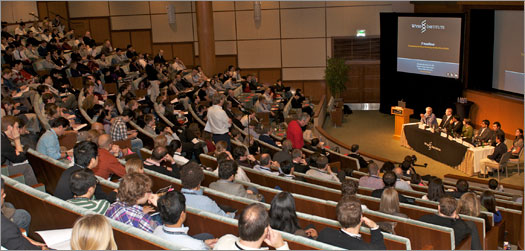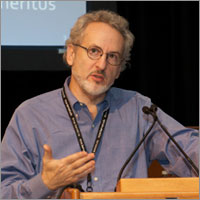From the many new research discoveries, to the dramatic increase in laboratory space, to last month’s technology licensing agreement, the Wyss Institute’s third annual retreat offered a dynamic window into the Institute’s unique model for innovation, collaboration and technology translation.
Founded in 2009, the Wyss Institute holds its annual retreat every November to share updates, identify synergies, and foster communication within its ever expanding community. This year about 320 faculty, fellows, students, staff, clinical partners, and other collaborators convened at the Seaport World Trade Center in Boston. By contrast, 140 people attended the 2009 inaugural event.

“We have pioneered a new approach that not only spurs innovation and scientific collaboration, but also bridges the ‘valley of death’ where so many new discoveries perish without ever having a chance to help people,” said Wyss Institute Founding Director Donald Ingber in welcoming attendees to the retreat. “We’re not just a research institute — we’re also an institute focused on technology translation.”
The mission of the Wyss Institute is to create new materials and devices that solve critical medical and environmental problems. Its unique model involves channeling nature’s inspiration into breakthrough innovations, advancing these breakthroughs through the collaborative efforts of diverse experts, and facilitating their development into viable products and devices through industry partnerships, licensing agreements, and new start ups.
The retreat began with an overview of commercialization efforts by members of the Institute’s Advanced Technology Team, who ensure that technology development is guided by real-world needs. For example, the Institute’s organ-on-chip technology, in which living human organ functions are reconstituted on microchips for use in drug safety and efficacy testing, is a direct response to the pharmaceutical industry’s critical need for accurate and cost effective alternatives to traditional animal testing models.

Howard Stevenson, Senior Associate Dean, Emeritus of Harvard Business School, provided the keynote address on “Innovation and Entrepreneurship,” commending the Wyss for its ability to value change, share resources, and create new possibilities by working together in new ways. In addition to presentations by scientists and engineers in each of the Institute’s six technology platforms, nearly 140 poster abstracts of ongoing research projects were on display — up from 80 posters in 2010.
Ingber pointed out several other markers of the past year’s growth including the significantly expanded laboratory space at both the Longwood and Cambridge facilities, and the addition of new clinical and industrial partners, such as Spaulding Rehabilitation Hospital and companies in markets ranging from pharmaceuticals to chemicals and robotics. The Wyss’s partnership with K-Team, which is in the form of a license agreement for sale of its Kilobot robotic technology, was announced just last month.
Wyss scientists and engineers described the broad range of projects being undertaken, from slippery surfaces inspired by the carnivorous pitcher plant that will prevent blood clots in medical devices to swarms of tiny bioinspired flying robots that might one day be used in search and rescue missions.
Among the many other technologies highlighted were:
- Bacterial memory systems that record an organism’s history to discourage misuse of dangerous biological pathogens and protect high-value biocommodities
- An orthotic device to treat a thumb-in-palm deformity in children with cerebral palsy, giving them the ability to grasp and manipulate objects
- A rotary jet process, similar to a cotton candy machine, that creates highly aligned scaffolding for use in tissue engineering, such as repair of heart valves
- Adaptive windows based on the vascular system in which liquid flows through a network of embedded channels, cooling the surface and improving energy efficiency
- A microchip on which functional bone marrow has been generated for use in blood cell manufacture, stem cell studies, and in vitro drug testing
- Soft robots built of elastomeric materials that can achieve sophisticated movements, such as gait changes and gripping, and could one day be used in medicine
“Our goal at the Institute has always been to improve people’s lives and create a more sustainable planet,” Ingber said in closing the event. “After seeing the depth, diversity, and promise of all these technologies today, not to mention the great strides being made toward bringing many of these technologies to market, I think it’s fair to say that the Wyss ‘experiment’ is already a huge success.”